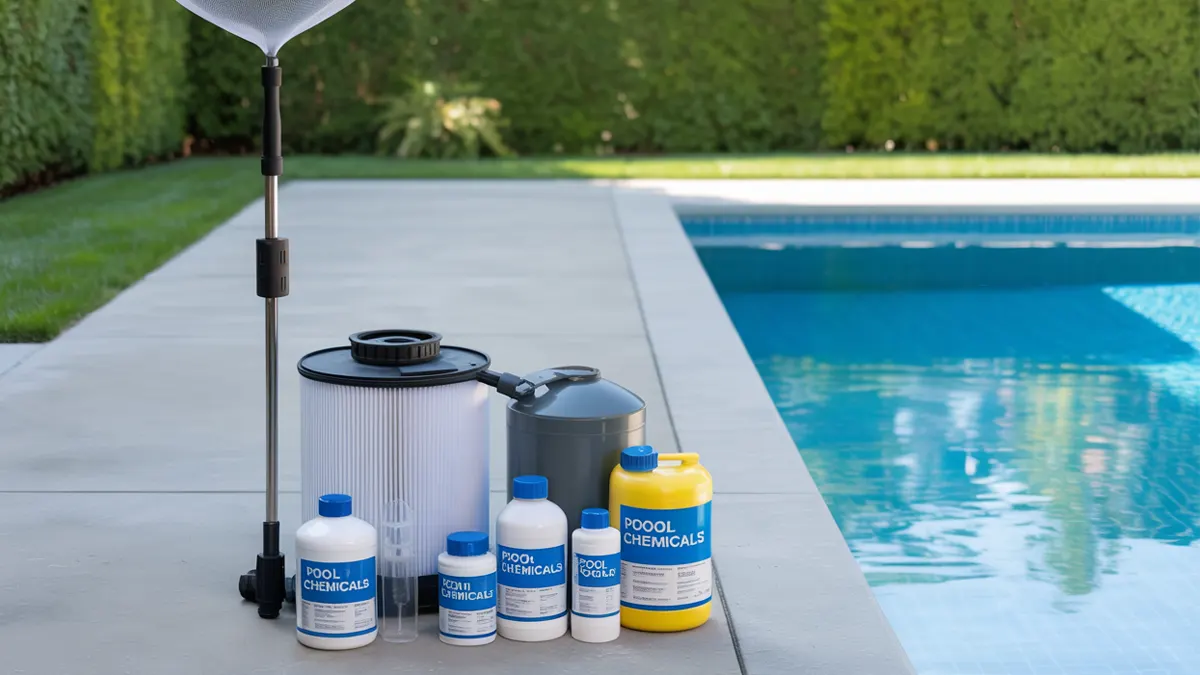
There’s something magical about stepping out into your backyard and plunging into your own private pool. But as any pool owner soon discovers, that magic comes with a price tag. A well-maintained, clean pool doesn’t just happen; it takes regular maintenance, a little science, and a whole lot of consistency.
Whether you’re a pool veteran or just wading in, this complete guide distills everything you need to know about caring for your pool so it remains safe, sparkling, and ready to swim all season long.
Keep It Clean: The Weekly Cleaning Routine
Keeping leaves out of your pool isn’t only about looks—it’s crucial to water quality and circulation. Here’s how to keep on top of it:
- Skim daily: Skim off floating leaves, bugs, and other surface gunk before they sink.
- Brush weekly: Algae and grime adore clinging to your pool walls, stairs, and tile grooves. Brushing them off keeps them from accumulating.
- Vacuum weekly: A manual or automatic pool vacuum removes trash from the bottom of the pool.
- Empty baskets: Regularly clean out your skimmer and pump baskets to prevent clogs and maintain good water flow.
Pro tip: The more frequently you skim and brush, the less difficult vacuuming is, and your pool remains healthier.
Master the Art of Water Chemistry
You don’t have to be a chemistry major to balance your pool, but some knowledge helps. Too acidic or too basic water will irritate, destroy equipment, and even invite algae to the party.
Here are the essential chemical levels to monitor:
- pH Level: Should stay between 7.2–7.6
- Chlorine: Keep it between 1.0–3.0 ppm to sanitize effectively
- Alkalinity: The Ideal range is 80–120 ppm, which helps stabilize pH
- Calcium Hardness: Maintain 200–400 ppm to prevent scaling or corrosion
- Cyanuric Acid: Helps protect chlorine from UV rays—ideal range is 30–50 ppm
Check your water at least 2–3 times a week with test strips or a liquid testing kit. Make adjustments with pool-grade chemicals, and always read the manufacturer’s directions.
Shock the Pool When Needed
Occasionally, your pool requires a deeper cleaning beyond regular maintenance. That’s when “shocking” is necessary—a treatment of a concentrated amount of chlorine (or non-chlorine shock) to destroy bacteria and dissolve organic matter.
When to shock:
- After a pool party or heavy swimmer load
- Post-rainstorm (rain introduces contaminants)
- When water starts looking cloudy or dull
- Weekly during peak season
Shocking resets your water. Just shock at night, when the sun will not evaporate the chlorine, and wait at least 8 hours before swimming.
Check and Maintain Water Levels
Water evaporates. Children splash. Rain pours in. All of this impacts your pool’s water level, which should remain at around the halfway point of your skimmer opening.
Too low? Fill with water via a hose. Too high? Drain a bit so as not to mess up the skimmer’s suction.
Having the proper level ensures your filtration system functions correctly and keeps chemicals in balance.
Keep Your Filter System Happy
Your pool filter is the behind-the-scenes hero of pool clarity. It filters out debris and provides circulation, which is crucial to chemical distribution and algae prevention.
Here’s a quick overview:
- Sand Filter: Backwash every 1–2 weeks
- Cartridge Filter: Remove and clean every 2–6 weeks, depending on use
- Diatomaceous Earth (DE) Filter: Backwash monthly and replenish DE powder
Pro tip: Don’t wait until the water appears dirty—clean it as a habit. A clean filter equates to improved water flow and reduced stress on your pump.
Inspect Your Equipment
Even the cleanest pool water is worthless without working equipment. Spend a few minutes every other week to check:
- Pool pump: Check for strange noises or leaks
- Heater: Make sure it’s heating consistently
- Timers and controllers: Test automated settings to ensure proper cycle times
- Automatic pool cleaners: Clean filters and hoses, and check for damage
Catching little problems early can save you hundreds of dollars in repair costs, not to mention hours of downtime.
Seasonal Transitions: Open and Close Like a Pro
Pools aren’t a set-it-and-forget-it affair—especially when the seasons change.
Winterizing:
- Thoroughly clean the pool
- Balance the chemicals and lower the water level
- Drain and store hoses, filters, and pumps
- Add winterizing chemicals and cover securely
Spring Opening:
- Remove and clean the cover
- Skim, vacuum, and brush the pool
- Reconnect and test all equipment
- Shock the water and test chemical levels before swimming
Opening and closing your pool properly extends its lifespan—and saves you a spring headache.
Learn More: Best Time to Build a Pool in Las Vegas: Weather & Costs
Feeling Overwhelmed? Pool R US Has Your Back
We understand. Pool care can be a full-time job, particularly when you’d rather be lounging with a cocktail in your hand. That’s where Pool R US comes in.
From weekly cleanings and seasonal starts to full-chemical management, Pool R US provides professional and affordable pool care that keeps your backyard running anew. With experienced techs and customized service plans, we take care of the hassle so you don’t have to.
Your Takeaway
Maintaining your swimming pool doesn’t have to be that hard. With a consistent cleaning routine, balanced chemicals, and a watchful eye on your equipment, you’ll have a pool that’s not only beautiful but also safe and long-lasting.
And when things get hectic (or chemistry gets complicated), Pool R US is a phone call away—here to take control so you can plunge into leisure, not liability.